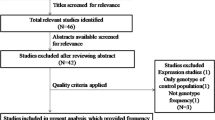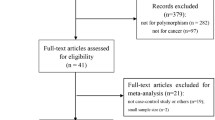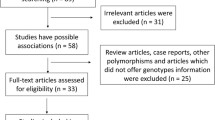Abstract
Objective The glutathione S-transferases (GSTs) are a superfamily of proteins that participates in detoxification. The GSTs were dividing into several classes including omega (GSTO), mu (GSTM) and theta (GSTT) classes. In human GSTO2, GSTM1, and GSTT1 are polymorphic. In order to study whether GSTO2, GSTM1, and GSTT1 polymorphisms are associated with increased gastric cancer risk in Iranian patients, the present case–control study was done. Methods Genomic DNA was extracted from peripheral blood of 67 gastric cancer patients and 134 control subjects. The genotyping was performed using PCR-based method. The possible association of gastric cancer with the GSTO2 N142D polymorphism was estimated with assuming additive, dominant, and recessive effect of the variant 142D allele. To investigate whether profiles of GST genotypes are associated with the risk of gastric cancer, we used unconditional logistic regression analysis. Results The GSTO2 142D allele in additive, dominant and recessive models was not associated with the risk. Because GSTM1, GSTT1, and GSTO2 genes belong to low-penetrance genes which might be involved in the carcinogenesis, patients and controls without family of cancer in first-degree relatives were also analyzes separately. To investigate whether profiles of GST genotypes are associated with the risk of gastric cancer, we used unconditional logistic regression analysis with GSTM1, GSTT1, and GSTO2 genotypes as predictor factors. The GSTO2 DD genotype was associated with decreased risk as compared to GSTO2 NN genotype (OR = 0.21, 95% CI: 0.05–0.92, P = 0.038). Conclusions Present findings show that GSTO2 DD genotype decreases the risk of gastric cancer in individuals without history of cancer in their first-degree relatives.
Similar content being viewed by others
Avoid common mistakes on your manuscript.
Introduction
The glutathione S-transferases (GSTs) are a superfamily of proteins that participate in phase II detoxification. They have important functions such as removal of reactive oxygen species, regeneration of S-thiolated proteins and conjugation of glutathione to endogenous and exogenous electrophile substrates [1, 2]. The GSTs were dividing into several classes including omega (GSTO), mu (GSTM) and theta (GSTT) classes [2].
The GSTO is a new identified subfamily of GSTs that has some different characteristics in structure and function from the other members of GST superfamily. They have a cysteine residue in their active site in contrast to serine or tyrosine that is in active sites of other subfamilies [3]. In addition, they catalyze the reduction of monomethylarsonic acid to monomethylarsonous acid that is the rate-limiting step in detoxification of inorganic arsenic [4].
GSTO class has two members, named GSTO1 and GSTO2. The human GSTO2 is a protein with 243 amino acid residues. In human, the GSTO2 is polymorphic with an N142D substitution in the coding region [5]. It is reported that the GSTO2 Asp142 (D142) variant allozyme showed 20% reduction in level of expression compared with the level of the GSTO2 wild type (N142) allozyme [6]. There were few studies, which investigated the association of GSTO2 N142D polymorphism and risk of several types of cancers, such as breast cancer, hepatocellular carcinoma, colorectal cancer, basal cell skin carcinoma, and ovarian cancer [7–10]. However, there is no data about the association between the genetic polymorphism of GSTO2 N142D and gastric cancer risk.
GSTM1 and GSTT1 are members of the GSTμ and GSTθ classes, respectively. In human, the GSTM1 and GSTT1 are polymorphic and the null alleles result in a lack of corresponding enzyme activities. Homozygosity for these null alleles (named the null genotypes) associated with increased risk of several multifactorial diseases such as several types of cancers [11–14], asthma [15], and cataract [16, 17]. Oxidative stress is involved in pathogenesis of these diseases. The GSTO2, GSTM1 and GSTT1, as low-penetrance susceptibility genes may act additively or multiplicatively, increasing the risk of gastric cancer. There is no published article describing the association between the GSTO2 N142D genetic polymorphism and gastric cancer risk. Therefore, the present case–control study was done.
Materials and methods
Subjects
The present study consisted of 67 subjects (22 females, 45 males) with pathologically confirmed primary gastric cancer that were recruited from chemotherapy department of Nemazi hospital in Shiraz (southern Iran), from October 1999 to August 2000 and from July 2004 to July 2005. Sex and age frequency-matched controls were randomly selected from the healthy blood donors. A total of 134 healthy individuals (44 females, 90 males) were included in the study. Exclusion criteria for controls included previous history of cancer and psychiatric disorders. The mean age (SD; Min–Max) of the patients and the controls was 57.7 (13.2; 24–82) years and 57.8 (8.6; 42–82) years, respectively. There was no significant difference between case and control groups (t = 0.03, df = 199, P = 0.973). Because Iranian population is one of the most heterogeneous populations, we select our patients and controls from Persian Muslims living in Fars province (southern Iran). Informed consent was obtained from each subject before the study.
Each subject (patients and controls) was asked to complete a self-administered questionnaire establishing demographic information, cigarette smoking status and family history of cancer in first-degree relatives. Each subject with at least one first-degree relative with cancer was considered as a case with positive family history.
DNA extraction and genotyping analysis
Genomic DNA was extracted from whole blood samples. Genotypic analysis for the GSTO2 N142D polymorphism was determined by PCR-RFLP method. Primers for amplifying the GSTO2 polymorphic site were 5′-AACCCTCCTAAAGCACCC-3′ and 5′-GCCTGTGAAAGCTGGTGTTAG-3′. PCR was performed in 20 μl final volume with 1.5 mM MgCl2, 0.2 mM each dNTPs, 0.5 pmol each primer, 0.2 μl of 10× PCR buffer (Cinagene Co., Iran) and 1 unit of Taq DNA polymerase. 94°C for 5 minutes as initial denaturation, 35 cycles of 94°C for 1 min; annealing 62.5°C for 1 min and 72°C for 1 min was thermal condition of PCR. Amplified segments were treated with MboI restriction enzyme and were incubated at 37°C for one overnight. Using 2.5% agarose gel stained with ethidium bromide; NN, ND and DD genotypes shown 420, 420/287/133 and 287/133 bp bands, respectively.
The PCR conditions for determining the GSTM1 and GSTT1 genotypes were the same as that reported previously. The absence of amplified product was consistent with the homozygous null genotype of GSTM1 and GSTT1. Successful amplification by β-globin specific primers confirmed the proper function of the PCR reaction. Evaluating the polymorphism and laboratory quality control were the same as that reported previously [13].
Statistical analysis
Selected characteristics were compared between cases and controls by using independent samples t-test and χ 2-test. A Chi-square test was performed for the polymorphism to determine if the control sample demonstrated Hardy–Weinberg equilibrium. The risk of cancer associated with the GSTO2 polymorphism was estimated. We first estimated the risk of the genotypes ND and DD compared with the wild-type NN homozygote, and then evaluated the risk of DD versus (ND + NN) and (DD + ND) versus NN, which assumed recessive and dominant effects, respectively, of the variant 142D allele. Unconditional logistic regression was used to calculate odd ratios (ORs) and 95% of confidence intervals (CIs) for the various genotypes. Data analysis was performed using SPSS software version 11.5. A probability of P < 0.05 was considered statistically significant. All P-values were two-tailed.
Results and discussion
The general characteristics of cases and controls are summarized in Table 1. Family history of cancer in first-degree relatives did not significantly differ between cases and controls (P = 0.152). However, smoking status differed significantly between them (P = 0.004). This finding is consistent with published reports from several populations [18–20].
Detailed genotype distributions are summarized in Table 2. Patient and control groups were initially divided into two sex groups. Since no statistically difference was observed between sex groups for the frequency of the GSTO2 N142D, GSTM1, and GSTT1 genotypes, the sex groups were pooled (data not shown).
The allelic frequency of 142D in our control group was estimated equal to 0.369. The genotypes of GSTO2 N142D in the control group were in Hardy–Weinberg equilibrium (χ 2 = 0.067, df = 1, P = 0.95). The frequency of GSTO2 142D allele was reported from several populations [5–10]. The frequency of 142D allele in our samples is similar to those of Caucasians, but has essential difference with African and American-African populations [5–10].
The ND (OR = 0.78, 95% CI: 0.42–1.44, P = 0.426) and DD (OR = 0.43, 95% CI: 0.15–1.26, P = 0.125) genotypes were not associated with an increased risk as compared to NN genotype. There was no linear trend for presence of 0, 1, and 2 of the 142D allele and risk of gastric cancer (χ 2 = 2.404, P = 0.121). In order to show whether the 142D allele has a dominant and/or recessive effect, we performed additional two comparisons. Assuming the recessive effect of the D allele (comparison between DD versus NN + ND), DD genotype did not increase the risk of the cancer (OR = 0.69, 95% CI: 0.38–1.26, P = 0.228). Assuming the dominant effect of the D allele (comparison between DD + ND versus NN), DD + ND genotypes were not associated with the risk of gastric cancer (OR = 0.49, 95% CI: 0.17–1.37, P = 0.173).
The frequencies of homozygous null genotypes of GSTM1 and GSTT1 in the control group were 44.8 and 28.4%, respectively, which were in accordance with recent data from our country [11–13, 15–18, 21]. In patient group, the frequencies of the homozygous null genotypes of GSTM1 and GSTT1 were higher in comparison with those of the control group, but these differences were not significant (For GSTM1: OR = 1.52, 95% CI: 0.84–2.74, P = 0.163; for GSTT1: OR = 1.50, 95% CI: 0.81–2.79, P = 0.198).
We know that GSTM1, GSTT1, and GSTO2 genes belong to low-penetrance genes, which might be involved in the carcinogenesis [1, 11]. Therefore, patients and controls that had positive family history for cancer were excluded. Since one or more high-risk genes might have inherited in these patients and controls. To investigate whether profiles of GST genotypes are associated with the risk of gastric cancer, we used unconditional logistic regression analysis. The GSTM1, GSTT1, and GSTO2 genotypes were used as predictor factors. Table 3 shows ORs and 95% CI for various genotypes based on fitted model. The GSTO2 DD genotype was associated with decreased risk as compared to GSTO2 NN genotype (OR = 0.21, 95% CI: 0.05–0.92, P = 0.038). The homozygous null genotype of GSTT1 (OR = 2.34, 95% CI: 0.94–5.85, P = 0.068) and also the homozygous null genotype of GSTM1 (OR = 1.06, 95% CI: 0.48–2.35, P = 0.885) were not associated with risk of gastric cancer. If smoking habits (which differed significantly between patients and controls) were included in the unconditional logistic regression analysis as another predictor of gastric cancer risk, then same results were obtained. At that time the GSTO2 DD genotype was associated with decreased risk as compared to GSTO2 NN genotype (OR = 0.21, 95% CI: 0.05−0.96, P = 0.043).
In conclusion, our present findings show that GSTO2 DD genotype decrease the risk of gastric cancer in individuals without history of cancer in their first degree relatives. It should be noted that there were few studies that investigated association between GSTO2 N142D polymorphism and risk of several types of cancers. There was no significant association between the polymorphism and risk of several types of cancers such as breast cancer, hepatocellular carcinoma, colorectal cancer, basal cell skin carcinoma, and ovarian cancer [7–10]. Our present finding is consistent with these reports, if study only GSTO2 N142D polymorphism; and it is not consistent with these reports, if study GSTO2 N142D polymorphism and other polymorphisms of GSTs, such as GSTM1 and GSTT1. It may be suggested that profiles of GST genotypes are important in gastric carcinogenesis.
The limitations of our study could not be ignored. The small sample size (and missing data for some subjects) may be criticized. Our study might not have sufficient power to detect an association between genetic polymorphisms of GSTs and gastric cancer due to small sample size. Also, there are several other single nucleotide polymorphisms for GSTO2 (in addition to N142D) in humans, which were not studied in the present work. Finally, gastric cancers are divided into proximal (cardia) and distal (noncardia) cancers that have different epidemiology [22]. This classification was not taken in consideration in the present study. Conducting future research using larger sample size and considering other potential related variables is highly recommended.
References
Sheehan D, Meade G, Foley VM et al (2001) Structure, function and evolution of glutathione transferases: implications for classification of non-mammalian members of an ancient enzyme superfamily. Biochem J 360:1–16
Nebert DW, Vasiliou V (2004) Analysis of the glutathione S-transferase (GST) gene family. Hum Genomics 1:460–464
Board PG, Coggan M, Chelvanayagam G et al (2000) Identification, characterization, and crystal structure of the Omega class glutathione transferases. J Biol Chem 275:24798–24806
Wang L, Xu J, Ji C et al (2005) Cloning, expression and characterization of human glutathione S-transferase Omega 2. Int J Mol Med 16:19–27
Whitbread AK, Tetlow N, Eyre HJ et al (2003) Characterization of the human Omega class glutathione transferase genes and associated polymorphisms. Pharmacogenetics 13:131–144
Mukherjee B, Salavaggione OE, Pelleymounter LL et al (2006) Glutathione S-transferase omega 1 and omega 2 pharmacogenomics. Drug Metab Dispos 34:1237–1246
Marahatta SB, Punyarit P, Bhudisawasdi V et al (2006) Polymorphism of glutathione S-transferase omega gene and risk of cancer. Cancer Lett 236:276–281
Leite JL, Morari EC, Granja F et al (2007) Influence of the glutathione S-transferase gene polymorphisms on the susceptibility to basal cell skin carcinoma. Rev Med Chil 135:301–306
Morari EC, Lima AB, Bufalo NE et al (2006) Role of glutathione S-transferase and codon 72 of P53 genotypes in epithelial ovarian cancer patients. J Cancer Res Clin Oncol 132:521–528
Pongstaporn W, Rochanawutanon M, Wilailak S et al (2006) Genetic alterations in chromosome 10q24.3 and glutathione S-transferase omega 2 gene polymorphism in ovarian cancer. J Exp Clin Cancer Res 25:107–114
Saadat M (2006) Genetic polymorphisms of glutathione S-transferase T1 (GSTT1) and susceptibility to gastric cancer: a meta-analysis. Cancer Sci 97:505–509
Saadat I, Saadat M (2000) The glutathione S-transferase mu polymorphism and susceptibility to acute lymphocytic leukemia. Cancer Lett 158:43–45
Saadat I, Saadat M (20001) Glutathione S-transferase M1 and T1 null genotypes and the risk of gastric and colorectal cancers. Cancer Lett 169:21–26
Lee SJ, Cho SH, Park SK et al (2002) Combined effect of glutathione S-transferase M1 and T1 genotypes on bladder cancer risk. Cancer Lett 177:173–179
Saadat M, Saadat I, Saboori Z, Emad A (2004) Combination of CC16, GSTM1, and GSTT1 genetic polymorphisms is associated with asthma. J Allergy Clin Immunol 113:996–998
Saadat M, Farvardin-Jahromi M (2006) Occupational sunlight exposure, polymorphism of glutathione S-transferase M1, and senile cataract risk. Occup Environ Med 63:503–504
Saadat M, Farvardin-Jahromi M, Saadat H (2004) Null genotype of glutathione S-transferase M1 is associated with senile cataract susceptibility in non-smoker females. Biochem Biophys Res Commun 319:1287–1291
Koizumi Y, Tsubono Y, Nakaya N et al (2004) Cigarette smoking and the risk of gastric cancer: a pooled analysis of two prospective studies in Japan. Int J Cancer 112:1049–1055
Sjödahl K, Lu Y, Nilsen TI et al (2007) Smoking and alcohol drinking in relation to risk of gastric cancer: a population-based, prospective cohort study. Int J Cancer 120:128–132
Crane SJ, Locke GR 3rd, Harmsen WS et al (2007) Subsite-specific risk factors for esophageal and gastric adenocarcinoma. Am J Gastroenterol 102:1596–1602
Saadat M, Dadbine-Pour A (2005) Influence of polymorphism of glutathione S-transferase M1 on systolic blood pressure of normotensive individuals. Biochem Biophys Res Commun 326:449–454
Crew KD, Neugut AI (2006) Epidemiology of gastric cancer. World J Gastroenterol 12:354–362
Acknowledgments
The authors are indebted to the participants for their close cooperation. The authors are indebted to Dr. Maryam Ansari-Lari for critical reading of the manuscript and for her contribution in discussion. This study was supported by Shiraz University.
Author information
Authors and Affiliations
Corresponding author
Rights and permissions
About this article
Cite this article
Masoudi, M., Saadat, I., Omidvari, S. et al. Genetic polymorphisms of GSTO2, GSTM1, and GSTT1 and risk of gastric cancer. Mol Biol Rep 36, 781–784 (2009). https://doi.org/10.1007/s11033-008-9245-0
Received:
Accepted:
Published:
Issue Date:
DOI: https://doi.org/10.1007/s11033-008-9245-0




